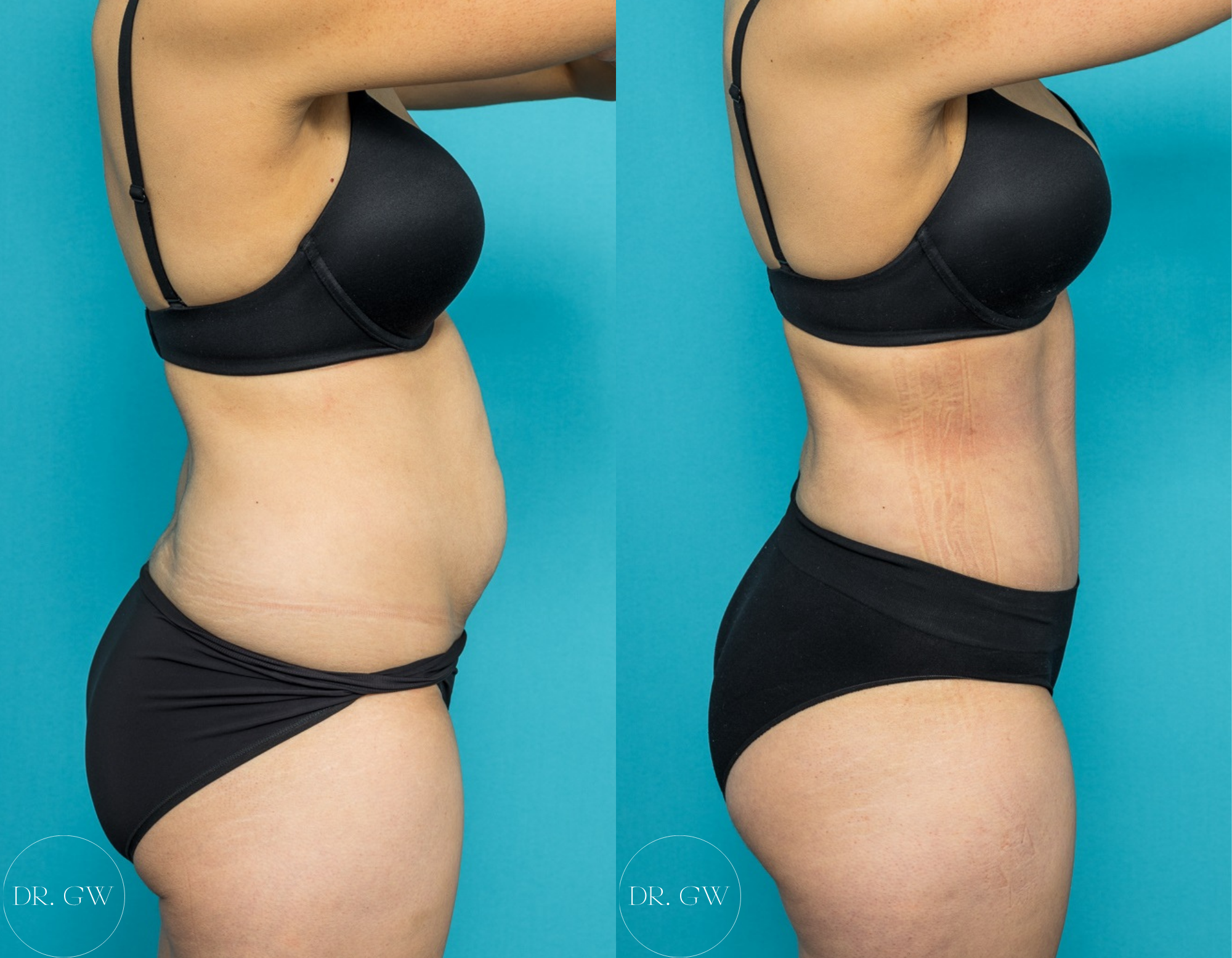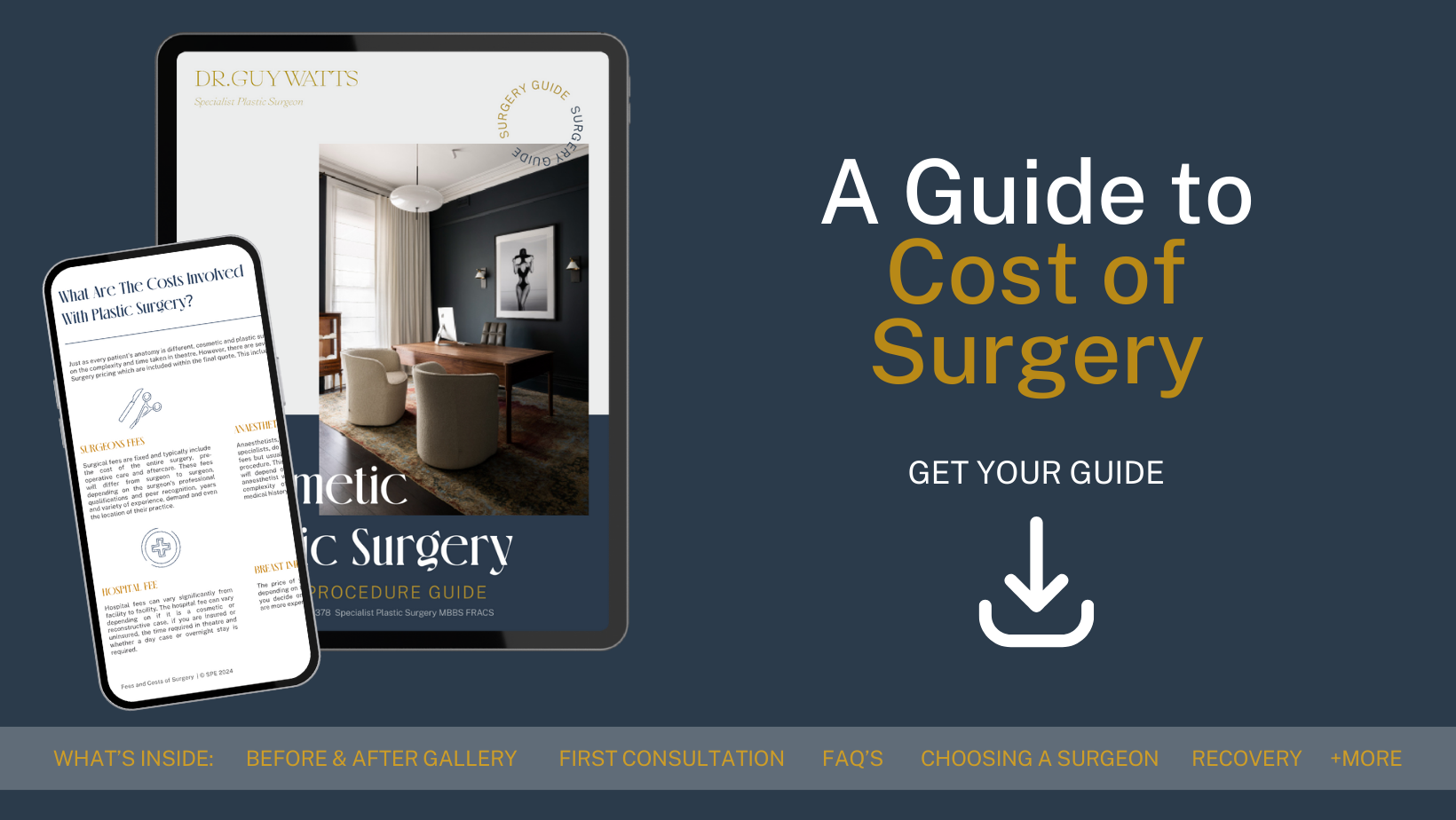
13 Aug How to Choose the Best Support Garments After Breast Surgery
Support garments are a vital component of recovery after breast surgery. Whether you’re preparing for breast augmentation, reduction, lift, or reconstruction – or male chest surgery – wearing the correct garment can influence comfort, wound healing, and tissue support during recovery.
For patients in Perth and throughout Western Australia, Dr Guy Watts, Specialist Plastic & Reconstructive Surgeon, provides detailed guidance on garment selection as part of his personalised post-operative care. This article explores how to choose the best support garments after breast surgery and why informed garment use is essential.
Take our quiz, and find out if you are ready for surgery
Why Are Support Garments Recommended After Breast Surgery?
Support garments are prescribed after breast surgery to assist the body in healing safely and effectively. These garments are not cosmetic; they’re a medical tool designed to promote functional recovery.
- Minimise oedema (swelling) and bruising: Compression garments apply gentle pressure to the chest area, which helps prevent the build-up of interstitial fluid. This minimises swelling and bruising, particularly in the first two weeks after surgery when fluid accumulation is most common. Reducing oedema not only makes patients more comfortable but may also lower the risk of seroma formation, a fluid collection under the skin that may otherwise require drainage.
- Support repositioned tissues or implants: After procedures like breast augmentation or reconstruction, breast tissues and implants need time to settle into place. A supportive garment stabilises these tissues, helping maintain symmetry and shape as swelling subsides and healing progresses. Without adequate support, there’s an increased risk of implant displacement or distortion of surgical contours.
- Protect incisions and minimise wound tension: Compression garments reduce tension across sutured areas, helping incisions stay closed and heal without stress. Reduced skin movement helps limit scarring and can lower the risk of delayed healing or wound complications.
- Encourage skin adherence and contouring: Gentle, uniform pressure encourages the skin to adhere to the underlying tissue. This is particularly important after fat removal or reshaping, as it supports smooth contours and uniform healing across the chest or breast area.
- Support posture and daily mobility: Especially during the early healing phase, garments help maintain posture and minimise chest discomfort during movement. Patients often report improved confidence during daily activities when wearing their garment, as it reduces bouncing or shifting sensations during walking or light household tasks.
Types of Post-Surgical Support Garments
Choosing the right style of support garment depends on the surgical procedure, body shape, and personal recovery plan. Dr Guy Watts discusses these options during pre-operative consultations at his Perth practice to ensure each patient is well-prepared.
Compression Bras
Compression bras are most frequently recommended for women following augmentation, lift, or reduction procedures. These garments are carefully engineered to meet the needs of post-surgical recovery.
- Designed without underwires to avoid placing pressure on healing incisions or newly positioned implants.
- Offer medium to firm compression that reduces swelling and supports tissue.
- Include wide, padded straps to distribute weight evenly and prevent shoulder strain.
- Provide front closures such as hook-and-eye or zip fastenings, enabling patients to dress without raising their arms – critical in the early days post-surgery.
Surgical Vests
Surgical compression vests are particularly suitable for male patients undergoing gynaecomastia surgery or those needing full upper torso compression.
- Cover a larger area than bras, including the flanks, sternum, and upper back, offering broader support.
- Provide firm, even compression that helps prevent haematoma or fluid build-up.
- Include adjustable Velcro or hook-and-loop panels for controlled tightness.
- Offer discreet wear under clothing, allowing patients to resume light daily activity with confidence.
Specialised Recovery Bras
These garments are tailored for patients recovering from more complex surgeries, including breast reconstruction or procedures involving surgical drains.
- Feature internal pockets for surgical drains or breast prostheses, helping secure medical devices without causing friction.
- Often include antimicrobial fabric coatings to reduce the risk of skin irritation and infection during prolonged wear.
- Provide extra soft materials like bamboo or modal fabric, which are gentle on hypersensitive or recently irradiated skin.
- May include wider underbust bands to prevent garment movement or rolling, supporting secure placement.
DOWNLOAD DR WATTS’ COST OF SURGERY ULTIMATE GUIDE

How to Choose the Best Support Garments After Breast Surgery
Selecting a support garment isn’t just about choosing a bra that fits. It involves several critical decisions that affect healing, comfort, and hygiene.
✓ Fit and Adjustability
- The garment should be snug enough to provide compression but not so tight that it impedes breathing or causes pressure marks. A correct fit supports circulation and keeps tissue in place without discomfort.
- Adjustable straps, back bands, and front closures are essential, as they allow for modifications as swelling reduces or healing progresses.
- Patients should trial garments prior to surgery when possible, ensuring there is no gaping, bunching, or excessive tightness in the chest area.
✓ Material
- Breathable, moisture-wicking materials are essential to maintain skin hygiene and prevent fungal or bacterial overgrowth, especially in warmer climates like Perth’s.
- Fabrics should be soft and hypoallergenic to reduce the risk of rashes or delayed wound healing caused by skin reactions.
- Thermal regulation is a plus – some materials can help patients remain cool in summer or warm in winter while still maintaining compression.
✓ Seam Placement
- Garments should feature flat seams or seamless construction wherever possible. Raised seams can irritate incision sites or leave indentations in the skin.
- Tagless designs or external care labels can prevent unnecessary rubbing or discomfort during prolonged wear.
✓ Ease of Use
- Front-fastening garments are ideal during the early stages of healing when upper body mobility is limited.
- Wide openings and minimal clasps allow carers or nursing staff to assist with dressing if required.
- Patients undergoing bilateral surgery may find zip-closure garments especially beneficial, as they eliminate the need to stretch or twist.
How Long Should You Wear Your Support Garment?
The length of time patients need to wear their garments depends on the surgical procedure and individual healing response. Dr Guy Watts advises on garment duration based on regular post-operative assessments at his Perth clinic.
- Weeks 1-2: During this period, patients typically wear the garment 24/7. This is when swelling is at its peak and tissues are still adjusting to new structural changes.
- Weeks 3-6: Garment use continues during daytime hours. Depending on healing progress, some patients may transition to lighter compression or soft bras at night.
- Beyond Week 6: Once tissues have stabilised and scarring has matured, patients may resume wearing regular bras or undergarments. However, in some cases – such as breast reconstruction – longer use may be advised.
Patients are reminded that stopping garment use too early can impact the final outcome. It’s essential to follow medical guidance rather than relying on comfort alone as a benchmark for discontinuation.
Common Concerns About Post-Surgical Garments
Will I need more than one garment?
Yes, having at least two garments is highly recommended. Recovery bras need to be cleaned regularly to maintain hygiene, particularly due to sweat, body oils, and wound dressings. Rotating between two garments allows one to be washed and dried while the other is worn, ensuring uninterrupted compression.
What if the garment feels too tight?
A support garment should feel firm but should never cause pain, numbness, or pinching. If you notice these symptoms – or marks that persist more than a few minutes after removal – this may indicate that the garment is too small or applied too tightly. Contact Dr Watts’ Perth clinic for assessment or garment refitting.
Can I sleep without it?
In most cases, the garment should be worn overnight during the initial stages of recovery. Movement during sleep can displace healing tissues or cause tension on sutures. Wearing the garment while sleeping helps maintain symmetry and comfort.
Caring for Your Garment: Hygiene and Maintenance
Support garments must be cared for diligently to ensure they remain effective:
- Hand wash or gentle machine cycle: Use cold or lukewarm water with fragrance-free detergent. Avoid bleach, fabric softeners, or harsh chemicals, which can degrade compression fibres.
- Air dry flat: Avoid hanging garments from the straps, as this can stretch the fabric. Never place garments in a tumble dryer, as heat damages elastic components.
- Inspect weekly: Check for signs of overstretching, weakened seams, or worn closures. A worn-out garment may lose its ability to provide proper compression.
- Rotate garments: This practice not only extends the life of the garments but ensures that compression is consistently maintained over the full recovery period.
Ongoing Support from Dr Guy Watts in Perth
Dr Guy Watts provides continuous care from pre-operative planning through to full recovery. As a Specialist Plastic & Reconstructive Surgeon in Perth, his commitment extends beyond surgery, ensuring patients feel informed, reassured, and supported.
- Garment recommendations are tailored to the surgical plan and reviewed at each follow-up appointment.
- Recovery assessments include checking garment fit, healing progress, and transitioning plans to less restrictive garments or regular wear.
- Patient education on hygiene, warning signs, and when to adjust or stop compression is a routine part of aftercare.
FAQs About Choosing and Using Support Garments After Breast Surgery
Final Considerations for Perth Patients
Support garments are a cornerstone of effective surgical recovery. From managing swelling to protecting incisions and promoting optimal tissue healing, their role is irreplaceable.
At his Perth-based practice, Dr Guy Watts, Specialist Plastic & Reconstructive Surgeon, ensures that each patient receives not only expert surgical care but also clear, evidence-based guidance for garment use. If you’re considering breast surgery or currently recovering, understanding your garment options is essential for a smooth and supported outcome.
Further Reading
-
- Read more about Guy Watts’ blog on How to Choose the Compression Garments after Breast Reduction
- Read more about Guy Watts’ blog on How to Reduce Bruising after Breast Reduction
About Dr. Guy Watts – MED0001539378
FRACS (Plas) – Specialist Plastic Surgeon In Perth WA
Dr. Guy Watts is a Specialist Plastic Surgeon (AHPRA MED0001539378) with an extensive career that spans across renowned plastic surgery clinics worldwide. His experience has been honed through invaluable experiences at esteemed establishments such as the New York Eye and Ear Infirmary and the renowned Pitanguy Clinic in Brazil.
Having collaborated with the foremost cosmetic plastic surgeons on a global scale, Dr. Watts has chosen to return to Perth after a 17-year journey of intensive training and invaluable professional experience to bring the latest practices and technology in cosmetic plastic surgery to his patients.
Dr. Watts is a Fellow of the Royal Australasian College of Surgeons (FRACS) and a Member of the Australian Society of Plastic Surgeons (ASPS), Australasian Society of Aesthetic Plastic Surgeons (ASAPS) and the International Society of Aesthetic Plastic Surgeons (ISAPS).
Read about the potential Risks and Complications of Surgery
Read the Patient Information and Resources
About CLINISPA
Clinispa is Dr Watts’ bespoke medical clinic performing Cosmetic Aesthetic treatments. At Clinispa, we offer advanced clinical treatments in a luxurious and calming environment, tailored to support your skin’s health and appearance.
Clinispa aesthetic services are performed by Dr Guy Watts’ nursing professionals, who have a passion for and solid understanding of facial aesthetics.
All Clinispa clients are considered individually, with a personalised treatment plan consisting of advanced scientific approaches to cosmetic aesthetics. We incorporate innovative technologies in conjunction with superiorly formulated skin care.
For more information about the full range of Clinispa Aesthetic of Cosmetic Treatments visit the Clinispa website








Sorry, the comment form is closed at this time.